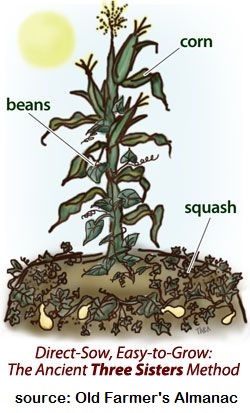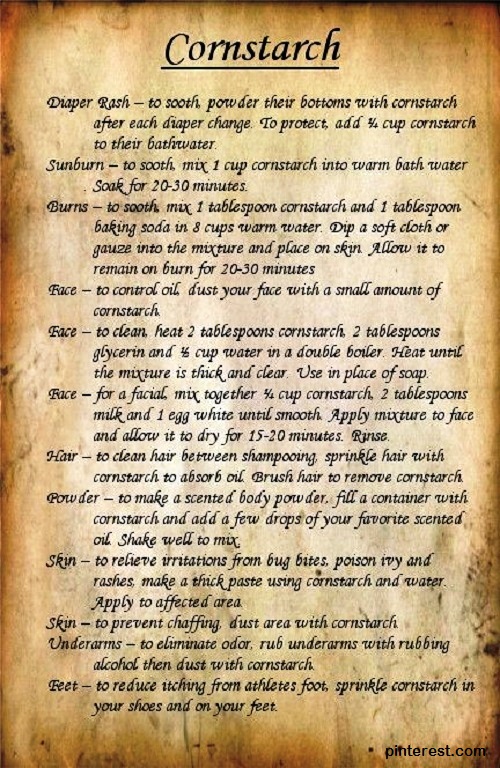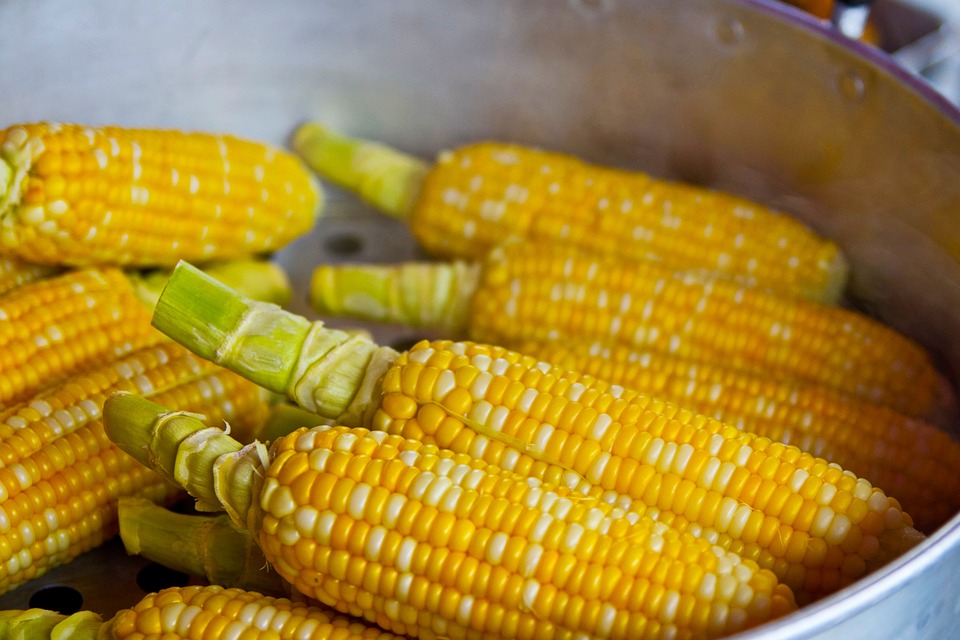Corn has a bad reputation today. Besides being genetically modified, corn today has been transformed into high-fructose corn syrup. It’s creeping into all kinds of foods and beverages where it never belonged.
The modern agriculture movement has taken this important crop and turned it into something to be avoided. The soil becomes so depleted it needs tons of fertilizer to continue producing. It’s been eroded, and completely disturbed. But a quick look at history will show that our ancestors depended on this staple crop.
It’s a calorie-dense food that’s fed countless people and animals throughout time. It grows six out of the seven continents, making it an ideal survival food in almost every climate.
Corn is a great addition to a survival garden. It’s fairly easy to grow, and is easier to harvest than other grains. There’s no need to thresh the corn crop after all.
Types of Corn
You just need to pick the right variety of corn. There are six main categories, but I’m going to focus on only three, sweet corn, field or dent corn, and popcorn. The other main types are flint corn, ornamental corn, and flour corn. Since these types have different uses, you’ll want to be sure and grow the kind or kinds that you need.
Sweet Corn
Harvested when the kernels are in the milky stage, sweet corn is what you find in the grocery store on the cob. It’s sweet, tender, and flavorful. Many gardeners plant varieties of sweet corn in their home garden.
Field (Dent) Corn
Field corn isn’t as sweet as sweet corn, but it has a multitude of uses. It’s used as animal feed, ground and turned into cornmeal, or prepared as grits. It’s perfect crop to grow for survival.
Before harvesting, field corn is allowed to dry a bit while still on the stalk. As the moisture leaves each kernel, a little dent appears.
Popcorn
If you have space to grow an extra variety of corn, consider popcorn. The kernels pop up fluffy and provide a nice snack.
After you’ve harvested your popcorn ears, you’ll have to dry out the kernels even more. Some growers prefer an oven, others let the sun do the job.
How to Grow Corn
No matter which variety of corn you decide to plant, make sure you find seeds that are open pollinated, heirloom varieties. These seeds haven’t been genetically modified, and they have a historical track record of helping nations survive.
If you plant more than one variety of corn, be sure to leave some space between them. At least 500 feet is recommended. Otherwise the different types of corn will cross pollinate and that can affect how each one tastes and grows.
Corn has a reputation of being a fairly needy crop. If you plant heirloom seeds, you won’t need to water it nearly as much as today’s popular varieties. After all, it survived all those years before irrigation was readily available. Mulch will help keep water in your soil.
However, this crop does require a lot of nitrogen. It’s known as a heavy feeder plant. In days past, each seed was planted on top of a dead fish. As the fish decomposed, it supplied the growing corn with the extra nitrogen it needed.
If fish aren’t in abundance where you live, you can also use compost and blood meal. You’ll want to give the soil an initial boost before planting. Once the corn reaches knee high, you’ll want to give it some more.
Corn thrives in soil that drains well. You should pick a location with full sun. You’ll want to know the length of your growing season, and plant a variety that does well.
Where I live, the growing season is on the short end. We often have killing frosts until Memorial Day or even a little past then. The locals recommend starting seed indoors and transplanting it to the soil in June. The saying here is that you want your corn, “knee high by the 4th of July,” but check with others in your area to learn what works best where you are.
 Rotate Your Crops
Rotate Your Crops
Because corn pulls many nutrients out of the soil, it’s important to rotate your crops each year.
Many people plant a cover crop after corn, to help improve the soil.
Harvesting Your Corn
Sweet corn is ready to harvest when the tassel begins turning dark brown. You’ll want to open up an ear and check to make sure the kernels are milky. You also want to make sure the kernels are well developed and plump.
If the liquid from the kernels is watery, it’s too early to harvest. Let them continue to develop and test again later.
Field corn and popcorn need to be left on the stalks longer. They’ll begin the drying process before you harvest them.
To pick corn, twist the ear gently towards the ground. It’ll break off. Sweet corn is best picked on the day you’re planning on eating or preserving it. That’ll keep the flavor the best.
Preserving Your Corn
Once you’ve picked your corn, it’s time to eat it or preserve your harvest. You’ll need to shuck your corn, removing the silk and husks. But hang onto at least some of these—we’ll cover their benefits in a later section.
You can stockpile sweet corn in a couple of ways. You can dry it, freeze it, or can it. There are pros and cons to each method, but drying and canning are probably better for survival purposes. You might not always have electricity to run your freezer.
Field corn and popcorn are dried and stored either on the cob or as kernels. When you’re ready to cook field corn into cornbread, you’ll need to grind it into flour first. Be sure your grain mill can handle corn.
If you’ll be feeding corn to your critters, you can store it on the cob in a corn crib. The slats on this structure ensure that air can circulate around the cobs. This will keep them from molding.
Using Corn
Now that you have yourself some corn, what can you do with it? Corn can be used in recipes, to improve your health, and around the homestead. It’s a versatile crop.
As Food
Since corn stores so well, it’s an ideal addition to your food stockpiles. Once you’ve dried some kernels, you can easily roast it and turn it into parched corn. These original corn nuts will be handy to take on the road.
Cornmeal mush is another way to use your corn. Mix 2 cups of corn meal with 2 cups of cold water. Bring 6 cups of water to a boil, and carefully add the cornmeal mixture. After it returns to a boil, reduce the heat and let it simmer while you stir occasionally. It’ll take about ten minutes to thicken up.
Whole kernel corn is a popular ingredient in salsa. You can combine your corn with other produce from your garden to create a delicious dip.
You can pop your popcorn in a pan with a little oil. Put a tablespoon of oil in a cold pan, and add enough popcorn to evenly cover the bottom of the pan. You don’t want to add too many kernels or it’ll burn. Cover your pan, turn on your burner, and slowly heat the pan.
You’ll want to shake fairly frequently. This will prevent any from sticking and burning. When the popping slows, remove the pan from the heat. Let it sit for a minute or two in case any additional kernels pop. Serve with butter, salt, and any of your favorite seasonings.
Corn used in plenty of other recipes as well or you can turn it into flour or use it to feed your chickens. You can even use corn husks to wrap tamales in. Take time now to try some recipes and see what you and your family enjoy eating. That way survival foods won’t come as a shock to their system.
As Medicine
Corn silk tea has historically been used as a diuretic. It’s used to treat bladder and kidney ailments. You’ll want to finely chop your clean corn silk. Then, steep a tablespoon of this in a cup of hot water for ten or fifteen minutes. Strain out the silk before drinking.
In addition to its diuretic benefits, corn silk tea helps the body release extra fluid. It’s a gentle detoxifying agent.
Corn silk can also be used topically. It has some antiseptic effects, which helps promote wound healing.

Around the Homestead
Corn has been used as animal feed throughout history. If you’re looking for an inexpensive way to feed chickens or raise hogs, corn can help. Typically, you’d crack the corn through a grain mill once before feeding. The act of cracking the corn helps the animals to break it down better.
Saving Seed for Future Harvests
It’s important to save some of your crop each year to plant the following year. Not having to purchase seeds every year will help you become more self-sufficient. Saving corn seed is fairly simple.
You want to harvest your ears after the husks become dry. Then, you need to ensure the kernels are thoroughly dry. You can hang the ear upside down to help dry it out evenly.
Once dried, shell your corn. These seeds should be stored in a cool, dry location. They will remain viable for several years if properly stored.
Final Thoughts on Corn
Corn that hasn’t been genetically modified is a survival crop utilized throughout history. It’s beneficial as a food, for its medicinal purposes, and for feeding your animals.
Are you currently growing this essential crop? What varieties grow best in your neck of the woods? Please share your corn tips and tricks in the comment section, and click on the banner below to find out more survival secrets from our ancestors!
This article has been written by Lisa Tanner for Survivopedia.






















































































Using corn as a survival food is incomplete without discussion of the nixtamalization process. Raw corn is not as nutritious as nixtamalized corn and was the source of many cases of pellagra and malnutrition when western civilization was first introduced to corn as a food source because of the lack of knowledge of the nixtamalization process.
Growing corn in small 5 row plot in back yard, planted seeds in mid May, mulch compost worm dirt, chicken manure really boosts healthy thick stalks, very green plants. It’s already over waist high, watering is not a problem I use the hose at night. I’m new at gardening and enjoy it very much!
Hi Robert! Where do you live (area, usda zone)? Couple of comments for a newbie gardener (waist high by the 4th of july is pretty dang good btw)…NEVER water at night. The longer water stays on plant material is a sure fire way to get fungus among us. Is corn all you got going? Water DEEPLY and allow to dry out before watering again. Makes vigorous and deep root systems, and drought resistant. Never use raw organic matter esp. poop. Make sure it is fully (aged) decomposed before using. Over the winter think about using a green crop such as annual rye, buckwheat…there is a bunch of this quick growing annuals to chose from. In the spring just dig it all into the soil. These green crops out compete any weeds…and you’ll probably get lots as chicken manure is filled with weed seeds. And this will get organic material into your soil which is what really helps retain moisture, feed the very critical micro and macro organism community that plants need. Books by Shane Smith (don’t worry about greenhouse versus outdoor gardening, lots of easy to understand brilliant stuff), Michael Dirr…Jorge Cervantes puts out a wonderful book, ‘The Cannabis Encyclopedia’ that is WONDERFUL. It is based on ONE PLANT’S NEEDS, instead of thousands of different plants and his detail is incredible. Don’t have to grow cannabis to get tons of knowledge from this book. Good luck fellow gardener…grins.!!
Nice article Lisa. I was hoping you’d have some magic to grow corn in Zone 1B. Too short of a season and it can freeze any night all year round. Have you grown corn in a green house?
GMO corn is everywhere and the pollen would make a genetically perverse seed, yes? A greenhouse might help a bit but if properly aerated in the day time still going to have contact with pollen from nearby commercial fields, yes?
We’ve redone our greenhouse as last fall, October, we got snow that imploded our hoop house. Have you done any soil tests lately? How were the heavy metal levels?
Another one size fits all article. Unless you go through great efforts you can only grow corn here as a hobby and not as a commercial or survival venture. When reading these articles one must realize what works and what doesn’t in their area and what disasters for their area they must prepare for. Here I wouldn’t prep for a hurricane or tornado or snow storm but I would for an earthquake.
Excellent advice oldalaskan…our zone is the same as most of Alaska yet our latitude (Oregon) is almost to California…we are over 4,000 feet so that is why but the soils are totally pumice. We are dreaming of Alaska someday…soon!
Rabbits and goats and even cattle will happily eat the leaves and stalks of corn plants, especially when they’re still green, so that’s another animal feed option.